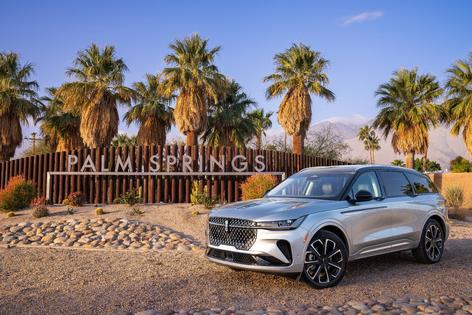Eric's Autos: 2025 Lincoln Nautilus
There used to be luxury brands. Most of them have morphed into luxury-sport brands. The distinction is important -- if you don't especially want a "sporty" ride but do very much want a luxurious one.
In that case, you may like the Lincoln Nautilus.
What It Is
The midsize Nautilus is a midsize crossover with two rows of seats, and like all of Lincoln's models, the emphasis is on luxury rather than sport. It does not tout its high-speed cornering capabilities or its ability to lunge quickly from 0 mph to 60 mph like a muscle car. It touts such luxuries as an ultra-plush interior with available massaging seats, a 28-speaker Revel Ultima audio system, streaming audio and video services and mood lighting with keyed-to-the-lighting scent diffuser designed to make a drive feel more like a trip to a spa. That's what makes it very different from the luxury-sport crossovers in the same general class.
There are three trims, beginning with the $53,940 Premier. It comes standard with a 4-foot-wide (48-inch) curved digital dash that spans the length of the upper dashboard, a 10-speaker stereo, streaming audio and video, synthetic leather seats and BlueCruise hands-free self-driving tech.
The $63,180 Reserve adds an adaptive suspension, real leather seat covers, wood interior trim and an illuminated Lincoln star; you can opt for the 28-speaker Revel Ultima audio system and massaging seats, which are bundled as part of a Reserve II package.
The $77,130 Black Label comes standard with all of the above plus 22-inch wheels, a panorama sunroof, additional Lincoln badge illumination, copper grill accents, Venetian leather seat covers, heated rear sets and a bundle of concierge services such as pickup and delivery of the vehicle when service is required, complimentary car washes and rental car benefits through Avis.
All trims come standard with a 2.0-liter turbocharged four-cylinder engine, an eight-speed automatic and all-wheel drive, and all trims can be ordered with an optional hybridized version of the 2.0-liter engine, paired with a battery pack and motors that bump the combined output to 310 horsepower (from the standard 270) and increases overall fuel economy by about 6 mpg.
It's a standalone option that adds $2,500 to the price of any Nautilus.
What's New for 2025
Upgraded connectivity and entertainment features plus revised interior/exterior trim and color schemes constitute the major changes for this model year.
What's Good
-- Extremely plush on the inside (and how it rides).
-- Numerous clever storage cubbies.
-- Hybrid drivetrain adds only slightly to the cost, and you can get it in any trim.
What's Not So Good
-- Streaming video (e.g., YouTube) feature only works in "park."
-- The massaging seats and Revel 28-speaker audio system are restricted to the much more expensive Reserve and Black Label trims.
Under the Hood
All Nautilus trims come standard with the same drivetrain, consisting of a 2.0-liter turbo-boosted four paired with a full-time AWD system and an eight-speed automatic transmission. This combo touts 250 horsepower, 280 foot-pounds of torque and the ability to get the Nautilus to 60 mph in about seven seconds.
More power -- and quicker acceleration -- are available. Along with better gas mileage. All trims can be equipped with an optional ($2,500) hybrid drivetrain that replaces the eight-speed automatic with a continuously variable transmission plus a battery pack/electric motor to produce 310 horsepower and a roughly 6 mpg overall uptick in fuel economy. The hybrid also brings the 0-60 mph time down by about one second, enough to feel the difference.
As with most hybrids, the hybrid side -- the battery and electric motors (the Nautilus has two) -- powers the accessories when the engine isn't running as well as power boosts when maximum acceleration is wanted.
Lincoln says the Nautilus can tow up to 1,700 pounds.
On the Road
The Nautilus is a crossover -- and there lots of them, including at least six in the same general class and price range. But the Nautilus is not the same as the rest because it isn't trying to be. The object of this exercise is luxury and elegance rather than luxury and sport.
The distinction's no small thing. It is the difference between a vehicle that is fun to drive and one that makes the drive exceptionally pleasant. There can be overlap, but the point here is that most vehicles that are fun to drive aren't as fun on long drives or the ones that seem to take forever because of the traffic. What good is a luxury-sport crossover that can accelerate from 0 mph to 60 mph in less than five seconds if you can't get to 60 mph because the traffic isn't even doing 30 mph?
It is in such circumstances that crushed suede massaging seats and a 28-speaker audio system make where you're stuck feel like where you want to be. You can even pull off the road to wait out the traffic while watching a movie, which you can stream through the big screen. At night, with the mood lighting accompanying, it's like driving a private theater like the really flush people have at home.
Once the traffic uncongeals, the trip home is what it ought to be in a luxury vehicle. You do not "feel the road." The whole point of luxury as it pertains to driving is to not feel it. To float along serenely, even on potholed roads. You feel the comforting heft of the vehicle as it absorbs and dissipates the irregularities of the road.
Even the steering wheel isn't sporty. It is a flattened circle, which makes it easier to steer the Nautilus with less effort due to the leverage advantage. Of a piece, the tires -- which are "M+S" rated -- meaning sound and comfort (not mud and snow).
At the Curb
Lincoln put a lot of detail work into making the Nautilus elegant -- in the manner of classic Lincoln luxury cars. The door pulls are not the cliche copies of flush-mounted Tesla pulls that extend upon approach. They are formed as part of the upper door panels. It's a unique look and ergonomically natural; it feels right to open a car door this way. These pulls are also never going to fail to extend due to some electric glitch, locking you out of your vehicle.
The interior is more like a luxury suite; it reminds me of the first-class pods some of the better airlines offer that totally insulate you from the other passengers so that you can enjoy your flight in privacy and total comfort, with everything you need at hand as well as anything you could conceivably want shy of an attentive stewardess bringing you drinks and an extra soft pillow.
The main attraction here is the spectacular curved LCD main panel that extends the entire width of the dash. It does not have the aftermarket, tacky appearance of other in-car touch screens, which look like they were just screwed into the place where the gauges used to be. The Lincoln's display traces the natural lines of the upper cowl/windshield, such that it is part of the whole rather than something just mounted there. The look is bold yet not obnoxious. This is a good way to describe Lincolns generally -- especially in relation to Cadillacs, which were (and still are) known for their showiness for its own sake.
As ultra-modern as the Lincoln's interior is, it's also retro in the sense that classic Lincoln design touches such as the push-button gear selector and brushed metal trim echo the elegance of the Lincolns of the '60s.
The Rest
The Lincoln's main weaknesses have less to do with style than with utility. The maximum tow rating -- 1,700 pounds -- is less than that offered by others in the class, some of which tout being able to pull up to 3,500 pounds. This latter enables them to pull a small camper, which the Lincoln can't.
The Bottom Line
Why compete when you don't have to?
========
Eric's latest book, "Doomed: Good Cars Gone Wrong!" will be available soon. To find out more about Eric and read his past columns, please visit the Creators Syndicate webpage at www.creators.com.
Copyright 2025 Creators Syndicate, Inc.








Comments